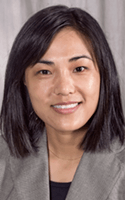Report shows rise in number of NPs in medically underserved area as number of doctors in those place declines
By Mike Costanza

More and more nurse practitioners are working in medically underserved parts of the US.
“The nurse practitioner workforce is growing and filling the low supply of physicians in those areas,” said Ying Xue, associate professor at the University of Rochester School of Nursing. Xue — who holds a Doctor of Nursing Science degree — is the lead author of “Primary Care Nurse Practitioners and Physicians in Low-Income and Rural Areas, 2010-2016,” which recently appeared in the Journal of the American Medical Association.
In New York state, NPs must be registered nurses who have graduated from a New York State Education Department-approved nurse practitioner education program, or been certified by an approved national certification program. They can specialize in 14 areas, including adult health, pediatrics and psychiatry. According to the American Association of Nurse Practitioners, 89 percent of U.S. NPs are trained to provide primary care in adult, family, gerontological or pediatric medicine and women’s health.
The degree of autonomy that an NP has in patient care depends upon the state in which he or she practices. In New York state, they are independently responsible for diagnosing and treating their patients as long as they satisfy certain requirements. For example, those who have less than 3,600 hours of professional experience must practice in accordance with written protocols. They must also have a written practice agreement with a collaborating physician, and satisfy other requirements. New York’s NPs do not need to work under a physician’s supervision.
Among primary care providers who are not physicians, NPs constitute the largest and fastest growing group in the country. In 2016, that group numbered 123,316, a nearly 52% increase over 2010. While that might comfort those in need of care, a 2017 study commissioned by the American Association of Medical Colleges projected that by 2030, the U.S. could face a shortage of as many as 104,900 physicians.
Those trends are playing out in rural and low-income areas across the U.S. Xue and her two colleagues analyzed data on the numbers of primary care nurse practitioners and physicians who were working in those locales during 2010 through 2016, along with the communities’ economic characteristics.
Among primary care providers who are not physicians, NPs constitute the largest and fastest growing group in the country.
The researchers found that the average number of physicians working in the poorest communities fell from 52.9 to 52 per 100,000 people over that period. In rural communities, the average fell from 59.5 to 47.8 per 100,000. Losses of this kind can reduce access to medical care.
“Adequate access to care is really related to health outcomes, so assuring that we have adequate clinicians serving in those areas is very, very important,” Xue explains.
By contrast, the average number of nurse practitioners who were working in the poorest communities was 19.8 for every 100,000 people in 2010. By 2016, it had more than doubled, to 41.1. Among rural communities, the average number of NPs jumped to 41.3 per 100,000 in that time, a nearly 64% increase.
“It’s very assuring that we see that there’s a growing trend of NPs at this time,” Xue says.
Xue suggests that growth in the number of community health centers in the U.S. might be drawing primary care nurse practitioners into underserved locales. According to the National Association of Community Health Centers, more than 11,000 community health centers serve America’s rural and urban communities. Over 28 million people turn to them for primary medical care.
“Those are the infrastructure that facilitate the clinicians to serve in those areas,” she explains.
Katie Sisson had other incentives. After working as a registered nurse at a Batavia hospital for a number of years, Sisson decided to become a family nurse practitioner. For about the last three years, she has practiced at Bergen Family Medicine, a primary care outpatient practice that serves about 2,400 patients in Bergen. The rural town sits about midway between Rochester and Buffalo.
“We have a population in this community of older, retiring physicians, and I saw a need to be met by nurse practitioners,” Sisson said.
In addition, her current job represents a kind of homecoming. Though she lives in Batavia, she’s a Bergen native.
“I actually grew up and went to school across the street from my practice,” she says. “So, for me, I’m giving back to the community.”
Bergen Family Medicine, which is part of the Rochester Regional Health System, has a relatively small staff — a physician, a registered nurse, two licensed practical nurses and three other employees, plus Sisson. She provides a full range of medical care for her patients.
“We offer a lot of services where people can really stay in their town to receive care,” Sisson says. “You’re using a lot of your clinical judgment and clinical skills.”
She relishes putting those skills to use for her patients.
“What gets me up and coming to work every day is the difference you make in their lives,” Sisson says.
